| Weight | 1 lbs |
|---|---|
| Dimensions | 9 × 5 × 2 in |
| host | mouse |
| isotype | IgG |
| clonality | monoclonal |
| concentration | concentrate, predilute |
| applications | IHC |
| reactivity | human |
| available size | 0.1 mL, 0.5 mL, 1 mL concentrated, 7 mL prediluted |
rabbit anti-TFE3 monoclonal antibody (ZR365) 6379
Price range: $160.00 through $528.00
Antibody summary
- Rabbit monoclonal to TFE3
- Suitable for: Immunohistochemistry (formalin-fixed, paraffin-embedded tissues)
- Reacts with: Human
- Isotype:IgG
- Control: Testis (germ cells) or Xp11 translocation renal cell carcinoma
- Visualization: Nuclear
- 0.1, 0.5, 1.0 mL concentrated, 7 mL prediluted
rabbit anti-TFE3 monoclonal antibody ZR365 6379
| antibody |
|---|
| Database link: human P19532 |
| Tested applications IHC |
| Recommended dilutions Concentrated 1:100-200 |
| Application Notes Positive control: Testis (germ cells) or Xp11 translocation renal cell carcinoma |
| Immunogen Recombinant full-length human TFE3 protein |
| Size and concentration 7 mL prediluted or 0.1, 0.5, 1.0 mL and concentrated |
| Form liquid |
| Storage Instructions 2-8°C for short term, for longer term at -20°C. Avoid freeze / thaw cycles. |
| Purity affinity purified |
| Clonality monoclonal |
| Isotype IgG |
| Compatible secondaries goat anti-rabbit IgG, H&L chain specific, peroxidase conjugated, conjugated polyclonal antibody 9512 goat anti-rabbit IgG, H&L chain specific, biotin conjugated polyclonal antibody 2079 goat anti-rabbit IgG, H&L chain specific, FITC conjugated polyclonal antibody 7863 goat anti-rabbit IgG, H&L chain specific, Cross Absorbed polyclonal antibody 2371 goat anti-rabbit IgG, H&L chain specific, biotin conjugated polyclonal antibody, crossabsorbed 1715 goat anti-rabbit IgG, H&L chain specific, FITC conjugated polyclonal antibody, crossabsorbed 1720 |
| Isotype control Rabbit polyclonal - Isotype Control |
| target relevance |
|---|
| Protein names Transcription factor E3 (Class E basic helix-loop-helix protein 33) (bHLHe33) |
| Gene names TFE3,TFE3 BHLHE33 |
| Protein family MiT/TFE family |
| Mass 61521Da |
| Function FUNCTION: Transcription factor that acts as a master regulator of lysosomal biogenesis and immune response (PubMed:2338243, PubMed:24448649, PubMed:29146937, PubMed:30733432, PubMed:31672913, PubMed:37079666). Specifically recognizes and binds E-box sequences (5'-CANNTG-3'); efficient DNA-binding requires dimerization with itself or with another MiT/TFE family member such as TFEB or MITF (PubMed:24448649). Involved in the cellular response to amino acid availability by acting downstream of MTOR: in the presence of nutrients, TFE3 phosphorylation by MTOR promotes its inactivation (PubMed:24448649, PubMed:31672913, PubMed:36608670). Upon starvation or lysosomal stress, inhibition of MTOR induces TFE3 dephosphorylation, resulting in transcription factor activity (PubMed:24448649, PubMed:31672913, PubMed:36608670). Specifically recognizes and binds the CLEAR-box sequence (5'-GTCACGTGAC-3') present in the regulatory region of many lysosomal genes, leading to activate their expression, thereby playing a central role in expression of lysosomal genes (PubMed:24448649). Maintains the pluripotent state of embryonic stem cells by promoting the expression of genes such as ESRRB; mTOR-dependent TFE3 cytosolic retention and inactivation promotes exit from pluripotency (By similarity). Required to maintain the naive pluripotent state of hematopoietic stem cell; mTOR-dependent cytoplasmic retention of TFE3 promotes the exit of hematopoietic stem cell from pluripotency (PubMed:30733432). TFE3 activity is also involved in the inhibition of neuronal progenitor differentiation (By similarity). Acts as a positive regulator of browning of adipose tissue by promoting expression of target genes; mTOR-dependent phosphorylation promotes cytoplasmic retention of TFE3 and inhibits browning of adipose tissue (By similarity). In association with TFEB, activates the expression of CD40L in T-cells, thereby playing a role in T-cell-dependent antibody responses in activated CD4(+) T-cells and thymus-dependent humoral immunity (By similarity). Specifically recognizes the MUE3 box, a subset of E-boxes, present in the immunoglobulin enhancer (PubMed:2338243). It also binds very well to a USF/MLTF site (PubMed:2338243). Promotes TGF-beta-induced transcription of COL1A2; via its interaction with TSC22D1 at E-boxes in the gene proximal promoter (By similarity). May regulate lysosomal positioning in response to nutrient deprivation by promoting the expression of PIP4P1 (PubMed:29146937). {ECO:0000250|UniProtKB:Q64092, ECO:0000269|PubMed:2338243, ECO:0000269|PubMed:24448649, ECO:0000269|PubMed:29146937, ECO:0000269|PubMed:30733432, ECO:0000269|PubMed:31672913, ECO:0000269|PubMed:36608670, ECO:0000269|PubMed:37079666}. |
| Subellular location SUBCELLULAR LOCATION: Cytoplasm, cytosol {ECO:0000269|PubMed:21209915, ECO:0000269|PubMed:22692423, ECO:0000269|PubMed:24448649, ECO:0000269|PubMed:30733432, ECO:0000269|PubMed:36608670, ECO:0000269|PubMed:37079666}. Nucleus {ECO:0000269|PubMed:21209915, ECO:0000269|PubMed:22692423, ECO:0000269|PubMed:24448649, ECO:0000269|PubMed:30733432, ECO:0000269|PubMed:36608670, ECO:0000269|PubMed:37079666}. Lysosome membrane {ECO:0000269|PubMed:24448649}. Note=When nutrients are present, recruited to the lysosomal membrane via association with GDP-bound RagC/RRAGC (or RagD/RRAGD): it is then phosphorylated by MTOR (PubMed:24448649, PubMed:37079666). Phosphorylation by MTOR prevents nuclear translocation and promotes ubiquitination and degradation (PubMed:22692423, PubMed:30733432, PubMed:36608670, PubMed:37079666). Conversely, inhibition of mTORC1, starvation and lysosomal disruption, promotes dephosphorylation and translocation to the nucleus (PubMed:22692423, PubMed:30733432, PubMed:37079666). {ECO:0000269|PubMed:22692423, ECO:0000269|PubMed:24448649, ECO:0000269|PubMed:30733432, ECO:0000269|PubMed:36608670, ECO:0000269|PubMed:37079666}. |
| Tissues TISSUE SPECIFICITY: Ubiquitous in fetal and adult tissues. {ECO:0000269|PubMed:8986805}. |
| Structure SUBUNIT: Homodimer and heterodimer; with TFEB or MITF (PubMed:15507434, PubMed:1748288). Interacts with RRAGC/RagC GDP-bound and RRAGD/RagD GDP-bound; promoting its recruitment to lysosomal membrane in the presence of nutrients (PubMed:24448649, PubMed:36608670). Interacts with TSC22D1; the interaction is enhanced in the presence of TGF-beta (By similarity). {ECO:0000250|UniProtKB:Q64092, ECO:0000269|PubMed:15507434, ECO:0000269|PubMed:1748288, ECO:0000269|PubMed:24448649, ECO:0000269|PubMed:36608670}. |
| Post-translational modification PTM: Sumoylated; does not affect dimerization with MITF. {ECO:0000269|PubMed:15507434}.; PTM: Phosphorylation ar Ser-47 and Ser-321 by MTOR via non-canonical mTORC1 pathway regulates its stability and subcellular location, respectively (PubMed:21209915, PubMed:24448649, PubMed:30733432, PubMed:36608670). When nutrients are present, phosphorylation by MTOR at Ser-47 promotes ubiquitination by the SCF(BTRC) complex, followed by degradation (PubMed:36608670). When nutrients are present, phosphorylation by MTOR at Ser-321 also promotes association with 14-3-3/YWHA adapters and retention in the cytosol (PubMed:24448649, PubMed:30733432). Phosphorylation at Ser-47 plays a more critical role than phosphorylation at Ser-321 for TFE3 inactivation (PubMed:36608670). Inhibition of mTORC1, starvation and lysosomal disruption, promotes dephosphorylation and transcription factor activity (PubMed:30733432, PubMed:36608670). {ECO:0000269|PubMed:21209915, ECO:0000269|PubMed:24448649, ECO:0000269|PubMed:30733432, ECO:0000269|PubMed:36608670}.; PTM: Ubiquitinated by the SCF(BTRC) and SCF(FBXW11) complexes following phosphorylation at Ser-47 by MTOR, leading to its degradation by the proteasome. {ECO:0000269|PubMed:36608670}. |
| Involvement in disease DISEASE: Intellectual developmental disorder, X-linked, syndromic, with pigmentary mosaicism and coarse facies (MRXSPF) [MIM:301066]: A disorder characterized by severe developmental delay with impaired intellectual development and poor speech, coarse facial dysmorphisms, and Blaschkoid pigmentary mosaicism. Additional clinical features may include epilepsy, orthopedic abnormalities, hypotonia, and growth abnormalities. The disorder affects both males and females. {ECO:0000269|PubMed:30595499, ECO:0000269|PubMed:31833172, ECO:0000269|PubMed:32409512, ECO:0000269|PubMed:36608670}. Note=The disease is caused by variants affecting the gene represented in this entry.; DISEASE: Note=A chromosomal aberration involving TFE3 is found in patients with alveolar soft part sarcoma. Translocation t(X;17)(p11;q25) with ASPSCR1 forms a ASPSCR1-TFE3 fusion protein. {ECO:0000269|PubMed:11358836}.; DISEASE: Renal cell carcinoma Xp11-associated (RCCX1) [MIM:300854]: Renal cell carcinoma is a heterogeneous group of sporadic or hereditary carcinoma derived from cells of the proximal renal tubular epithelium. It is subclassified into clear cell renal carcinoma (non-papillary carcinoma), papillary renal cell carcinoma, chromophobe renal cell carcinoma, collecting duct carcinoma with medullary carcinoma of the kidney, and unclassified renal cell carcinoma. RCCX1 histology shows both clear cells and papillary architecture, often with abundant psammoma bodies, although variable histologic features have been observed. {ECO:0000269|PubMed:8872474, ECO:0000269|PubMed:8986805}. Note=Disease susceptibility is associated with variants affecting the gene represented in this entry. Chromosomal aberrations involving TFE3 are found in patients with papillary renal cell carcinoma. Translocation t(X;1)(p11.2;q21.2) with PRCC; translocation t(X;1)(p11.2;p34) with PSF; inversion inv(X)(p11.2;q12) that fuses NONO to TFE3. {ECO:0000269|PubMed:8872474, ECO:0000269|PubMed:8986805}. |
| Target Relevance information above includes information from UniProt accession: P19532 |
| The UniProt Consortium |
Data
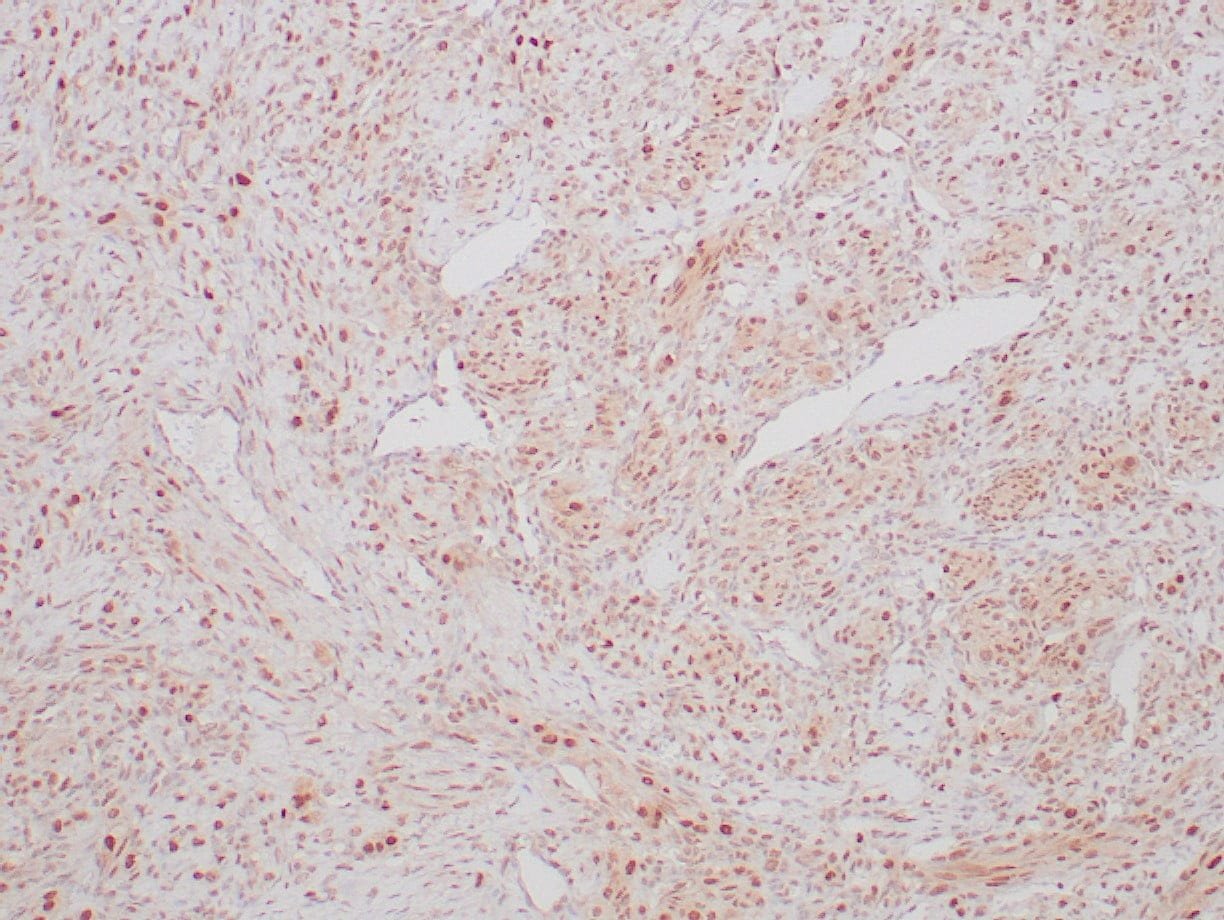 |
| Formalin-fixed, paraffin-embedded human ovarian sclerosing stromal tumor stained with anti-TFE3 antibody using peroxidase-conjugate and DAB chromogen. Note nuclear staining of tumor cells |
Publications
| pmid | title | authors | citation |
|---|---|---|---|
| We haven't added any publications to our database yet. | |||
Protocols
| relevant to this product |
|---|
| IHC |
Documents
| # | SDS | Certificate | |
|---|---|---|---|
| Please enter your product and batch number here to retrieve product datasheet, SDS, and QC information. | |||
Only logged in customers who have purchased this product may leave a review.
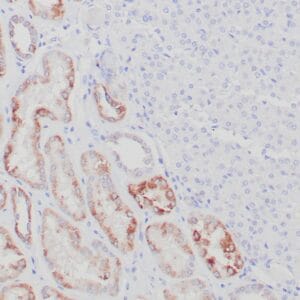
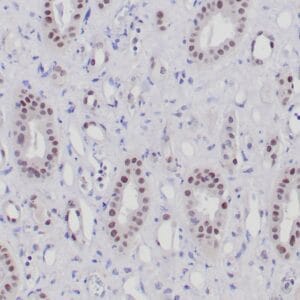
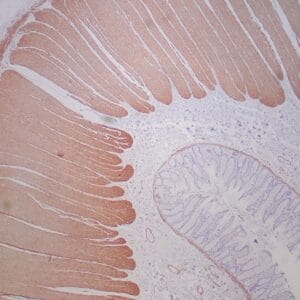

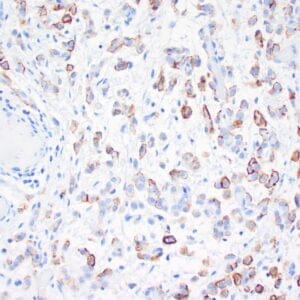
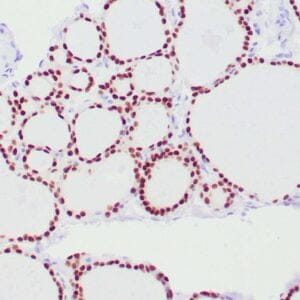
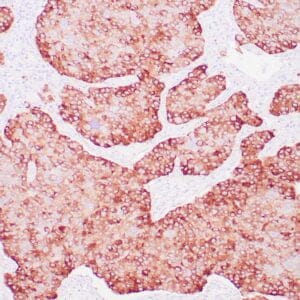
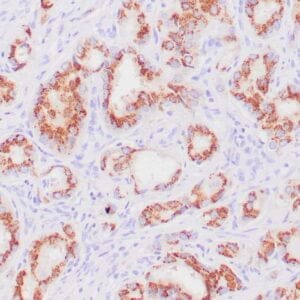

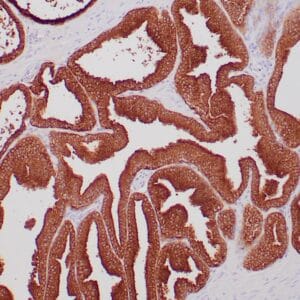
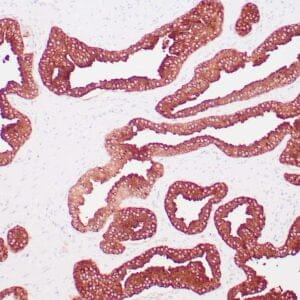
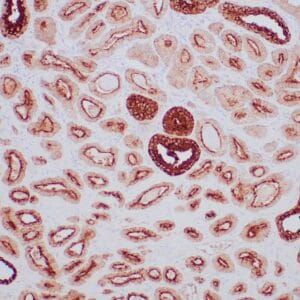
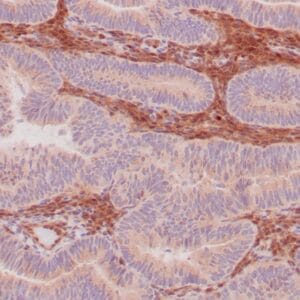
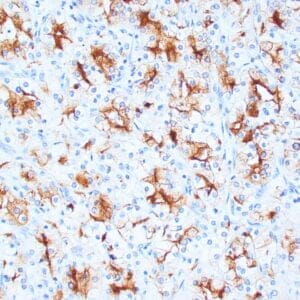
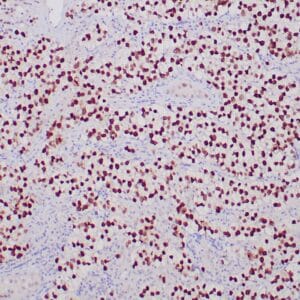
Reviews
There are no reviews yet.